Sukhoi Su-7 Video - Overview
|
|
Sukhoi Su-7
Su-7
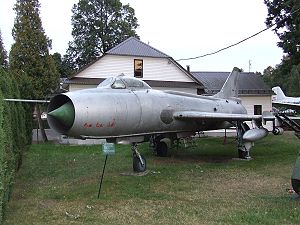
Picture - Su-7BKL
Role: Fighter-bomber
Manufacturer: Sukhoi OKB
First flight: 7 September 1955
Introduced: 1959
Retired: 1986 (Soviet Union)
Status: Limited Service
Primary user: Soviet Air Force
Produced: 1957-1972
Number built: 1,847
Developed into: Sukhoi Su-17
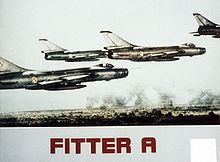
Picture - Su-7s of the Polish Air Force.
The Sukhoi Su-7 (NATO designation name: Fitter-A) was a swept wing, turbojet-powered fighter-bomber used by the Soviet Union and its allies.
Design and development
On 14 May 1953, the Sukhoi OKB was reopened and initially tasked with copying the American F-86 Sabre fighter. By the summer, the OKB began work on a swept-wing tactical fighter for establishing air superiority over the battlefield (frontovoi istrebitel, ÑÑонÑовой иÑÑÑебиÑелÑ, front-line fighter in Soviet terminology). The first prototype, designated S-1, was designed to use the new Lyulka AL-7 turbojet and it was the first Soviet aircraft to utilize the all-moving tailplane and a translating centerbody, a movable cone in the air intake for managing airflow to the engine at supersonic speeds. The aircraft also had a dramatic wing sweep of 60°, irreversible hydraulically boosted controls, and an ejection seat of OKB's own design.
The S-1 first flew on 7 September 1955 with A. G. Kochetkov at the controls. Fitted with an afterburning version of the AL-7 engine after the first 11 flights, the prototype set a Soviet speed record of 2,170 km/h (1,170 kn, 1,350 mph, Mach 2.04) in April 1956. The prototype was intended to be armed with three 37 mm Nudelman N-37 cannon and 32 spin-stabilized 57 mm (2.25 in) unguided rockets in a ventral tray. The second prototype, S-2, introduced some aerodynamic refinements. Testing was complicated by the unreliable engine and S-1 was lost in a crash on 23 November 1956, killing its pilot I. N. Sokolov. The aircraft entered service as Su-7 in 1959, although it saw only limited operational use.
On 31 July 1958, Soviet tactical aviation (Frontovaya aviatsiya, ÑÑонÑÐ¾Ð²Ð°Ñ Ð°Ð²Ð¸Ð°ÑиÑ) tasked Sukhoi with developing a ground-attack version of the Su-7. The resulting S-22 retained the basic layout of its S-2 predecessor, incorporating primarily structural refinements for high-speed low-altitude operations. It first flew in March 1959, and began entering service in 1961 as the Su-7B.
A total of 1,847 Su-7 and its variants were built, of which 691 were exported.
Operational history
Operationally, Su-7s were hampered by high takeoff and landing speeds dictated by the thin, highly-swept wing. The landing speed of 450 km/h (245 kn, 280 mph) combined with poor visibility from the cockpit and lack of an instrument landing system made for difficult operations, especially in poor weather. The death of at least one Indian pilot can be attributed, at least indirectly, to poor cockpit design. A pilot set his seating at a dangerous position "because he found the bomb sight and the front gun sight easier to operate" while in that position, and was killed on ejection. In 1961-1962, Sukhoi experimented with blown flaps on S-25 but the benefit was too small to warrant implementation. JATO rockets tested on S-22-4 proved more useful and were incorporated into Su-7BKL. Attempts to improve takeoff and landing performance eventually resulted in the Sukhoi Su-17.
Egypt
The Su-7 saw combat with Egypt in the 1967 Six Day War, the subsequent War of Attrition, and saw use in the Yom Kippur War by the Egyptians to attack Israeli ground forces.
India
The Indian Air Force used the Su-7 extensively in the 1971 war with Pakistan. The six Indian Su-7 squadrons flew almost 1,500 offensive sorties during the war, and undertook the bulk of the daytime attack efforts. The IAF managed to retain a very high operational tempo with its Su-7s, managing a sortie rate of six per pilot per day. Fourteen Sukhois were lost during the war, mostly due to AA-fire as IAF pilots conducted multiple passes over targets with insufficient fuel, but the type had acquitted itself well. After the war was over, it was found that the aircraft had received heavy AA fire in service , but still managed to fly home safely. Unconfirmed report mentions, one pilot RG Kadam of TACDE had shot down an F-86 Sabre flown by FL AJ Siddiqu, but was shot down by WC Hashmi, before he could make it back to base. However the kill was not mentioned by the Indian air force because it was not reported by the pilot. Similarly Wing Commander HS Mangat's Su-7 was badly damaged by a Sidewinder missile fired from an enemy MIG-19, the impact was so severe that half the rudder was missing, the elevators, ailerons and flaps were severely damaged, & half the missile was stuck in the chute pipe. The pilot made it back to his base, while Pakistan air force reported this incident as a kill.
Variants
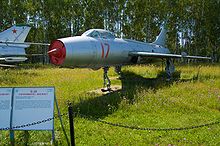
Picture - The S-26 on display at Monino
S-1 (Strelovidnoye [krylo] - swept wings) OKB-51 designation for the first prototype of the Su-7 / Su-9 family. S-2 OKB-51 designation for the first production version of the Su-7. S-22 OKB-51 designation for the Su-7B production aircraft. S-22-2 OKB-51 designation for the prototype of the Su-7BM. S-22M OKB-51 designation for the Su-7BM production aircraft. S-22KL OKB-51 designation for the Su-7BKL production aircraft, incorporating the Short field equipment tested on the S-22-4. S-23 As a pre-cursor to the S-22-4 tests, the S-23 was tested with a pure ski undercarriage and with skis on the main legs only S-22-4 An S-22 tested with wheel / Ski undercarrriage, brake Parachute and SPRD-110 JATO boosters for rough/unpaved field operations. S-25 This aircraft was used for Boundary Layer Control (BLC) tests, with compressor bleed air blown over the leading edges to reduce field length. S-25T A Su-7 fitted with the Boundary Layer Control system, rigged especially for use in a full-scale wind tunnel. S-26 A continuation of the S-22-4 testing with wheel/ski undercarriage, double brake parachute and JATO boosters (The S-26 survives on display at the Russian Air Force Museum, Monino). S-22MK A simplified export version of the Su-7BKL, designated Su-7BMK U-22 A belated trainer version with two seats in tandem in an extended nose based on the Su-7BM. U-22MK OKB-51 designation for the export version of the Su-7U, designated Su-7UMK by the VVS S-3 A projected interceptor version of the S-2, with 'Izumrud' radar and avionic equipment in a re-configured nose section. S-41 OKB-51 designation for the an experimental version of the S-1/S-2 with a lengthened nose and area-ruled rear fuselage. T-1 A delta wing tactical fighter project, based on the S-2, cancelled with the prototype nearly complete. T-3 A delta-winged interceptor version of the S-2, developed in parallel to the S-3 and T-1. This would eventually lead to the T-43 prototype of the Su-9 interceptor. Su-7 First production version, tactical air superiority fighter, factory designation S-2. Manufactured 1957-1960 with 132 built. Remained in operational service until 1965. Su-7B Ground attack version, factory designation S-22. Manufactured 1960-1962. Su-7BM Upgraded AL-7F-1 engine, upgraded fuel system with external piping on either side of the fuselage spine, fuel tanks installed in the wings, "wet" underwing hardpoints for carrying external fuel tanks, capable of carrying tactical nuclear bombs. Manufactured 1963-1965. Su-7BKL Rough-field capable variant with skids affixed to the sides of the main landing gear, provision for two SPRD-110 JATO rockets of 29.4 kN (13,300 lbf) thrust, and twin brake parachutes. Introduced in 1965, factory designation S-22KL. Manufactured 1965-1972. Su-7BMK A simplified export version of Su-7BM. Manufactured 1967-1971. Su-7U (NATO designation Moujik) Two-seat trainer version with reduced fuel capacity. First flight 25 October 1965. Manufactured 1966-1972 in parallel with the export version, designated Su-7UMK. Su-7UM Two-seat training version of the Su-7BM. Su-7UMK Two-seat training version of the Su-7BMK. Su-7IG Experimental variable geometry wing aircraft which was developed into Sukhoi Su-17. 100LDU Control Configured Vehicle A Su-7U modified with canards and a longitudinal stability augmentation system. It was designed as a testbed for a fly-by-wire system for the Sukhoi T-4. It was later used in 1973-1974 during the development of the Su-27's fly-by-wire system.
Operators
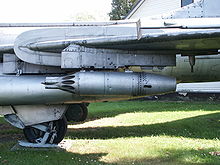
Picture - Su-7BKL landing gear with the unique skid, and a UB-16 57 mm rocket launcher
Current operators
North Korea
North Korean Air Force - 18 are in service with the North Korean Air Force.
Former operators
Afghanistan
Afghan Air Force - 46, including 16 Su-7U trainers, were delivered to the Afghan Air Force from 1972. Substantial replacement deliveries during the 1980s may have raised the total number of aircraft to serve to about 120. None remain in service.
Algeria
Algerian Air Force - The Algerian Air Force no longer operates the Su-7.
Czechoslovakia
Czech Air Force - The Czech Air Force operated 60 aircraft, last Su-7s were phased out in 1990.
Egypt
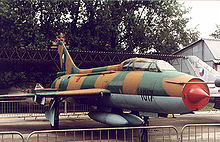
Picture - A two seat trainer variant Su-7UMK (NATO designation: Moujik)
Egyptian Air Force - No longer in service with the Egyptian Air Force
India
Indian Air Force - 140 aircraft delivered, no longer in service with the Indian Air Force.
Iraq
Iraqi Air Force - No longer in service with the Iraqi Air Force.
Poland
Polish Air Force - 46 were operated by the Polish Air Force, no longer in service.
South Yemen
South Yemen Air Force
Soviet Union
Soviet Air Force
Syria
Syrian Air Force
Vietnam
Vietnam People's Air Force
Specifications (Su-7BKL)
Data from Green, Sukhoi
General characteristics
Crew: One
Length: 16.80 m (55 ft 1 in)
Wingspan: 9.31 m (30 ft 7 in)
Height: 4.99 m (16 ft 4 in)
Wing area: 34 m² (366 ft²)
Empty weight: 8937 kg (lb)
Loaded weight: 13,570 kg (29,915)
Max takeoff weight: 15,210 kg (33,530 lb)
Powerplant: 1x Lyulka AL-7F-1 afterburning turbojet
Dry thrust: 66.6 kN (14,980 lbf)
Thrust with afterburner: 94.1 kN (22,150 lbf)
*Fuel capacity: 3,220 kg (7,100 lb)
Performance
Maximum speed: 1,150 km/h (620 kn, 715 mph, Mach 0.94) at sea level; 2,150 km/h (1,160 kn, 1,335 mph) at high altitude
Range: 1,650 km (890 nmi, 1,025 mi)
Service ceiling: 17,600 m (57,740 ft)
Rate of climb: 160 m/s (31,500 ft/min)
Wing loading: 434.8 kg/m² (89.05 lb/ft²)
Thrust/weight: 0.71
Takeoff roll: 950 m (3,120 ft)
Landing roll: 700 m (2,300 ft)
Armament
2 x 30 mm Nudelman-Rikhter NR-30 cannon, 80 rounds each
Up to 2,000 kg (4,410 lb) on six hardpoints, typically including two 950l or 600 l (160 US gal) fuel tanks under the fuselage, and a combination of 250 kg (551 lb) or 500 kg (1,102 lb) bombs and 57-mm spin-stabilized unguided rockets in UB-16-57U pods. A 8U69 5-kiloton nuclear bomb could be carried on the left fuselage hardpoint. Some versions could also carry two 600 l underwing drop tanks.
Related development
Su-17/Su-20/Su-22
Comparable aircraft
Hawker Hunter
Nanchang Q-5
HAL HF-24 Marut
F-105 Thunderchief
Living Warbirds: The best warbirds DVD series.
Source: WikiPedia